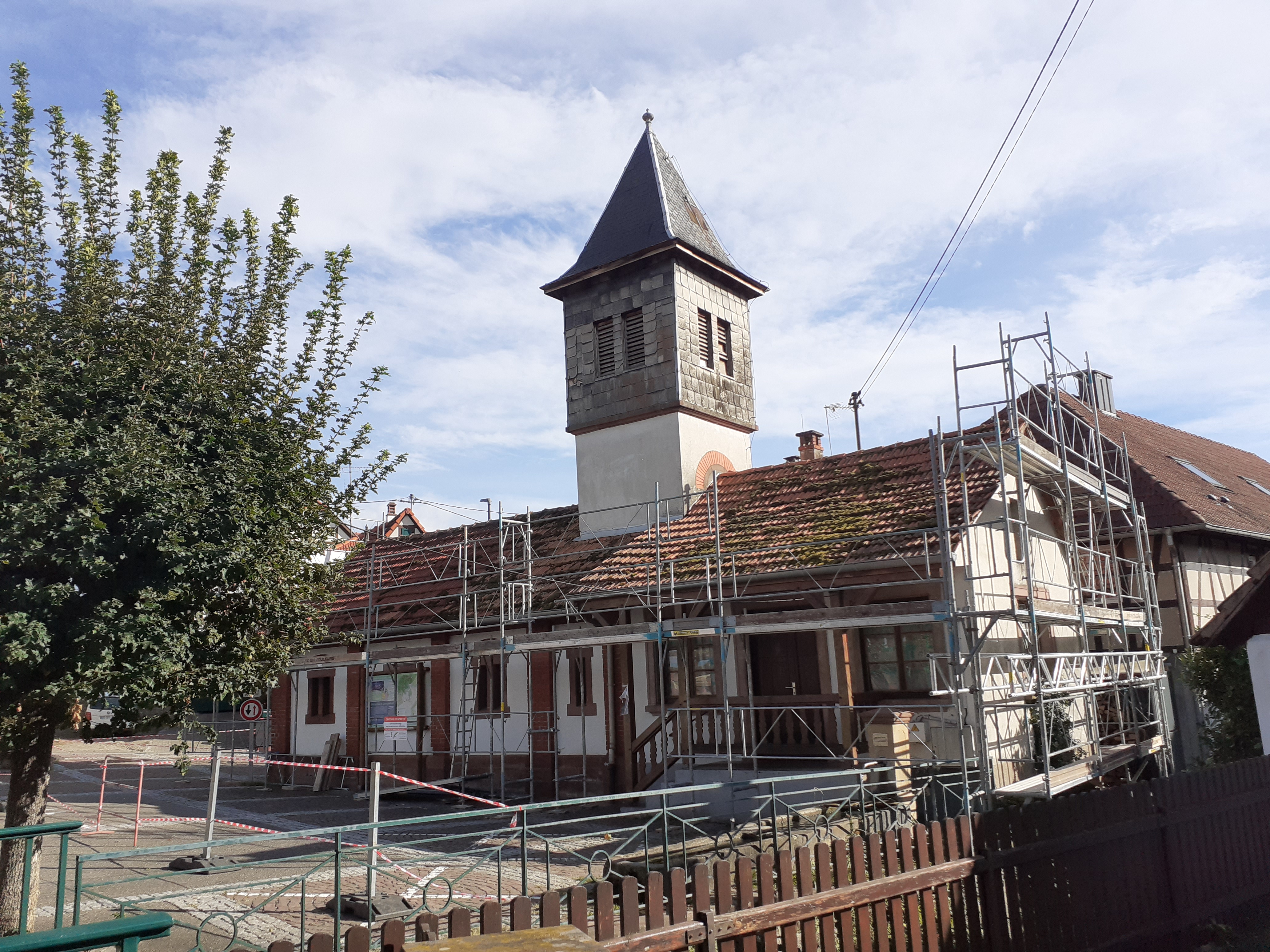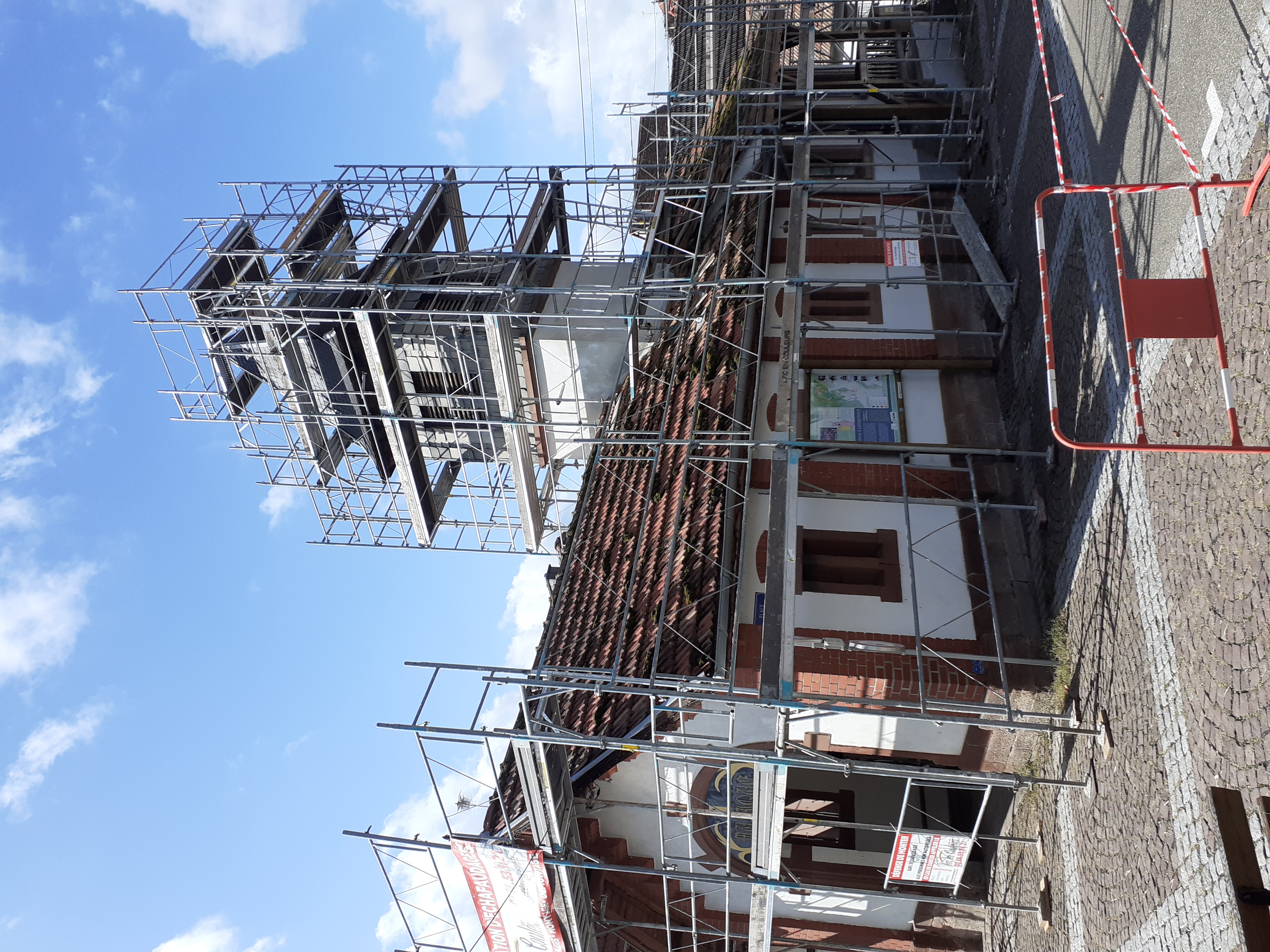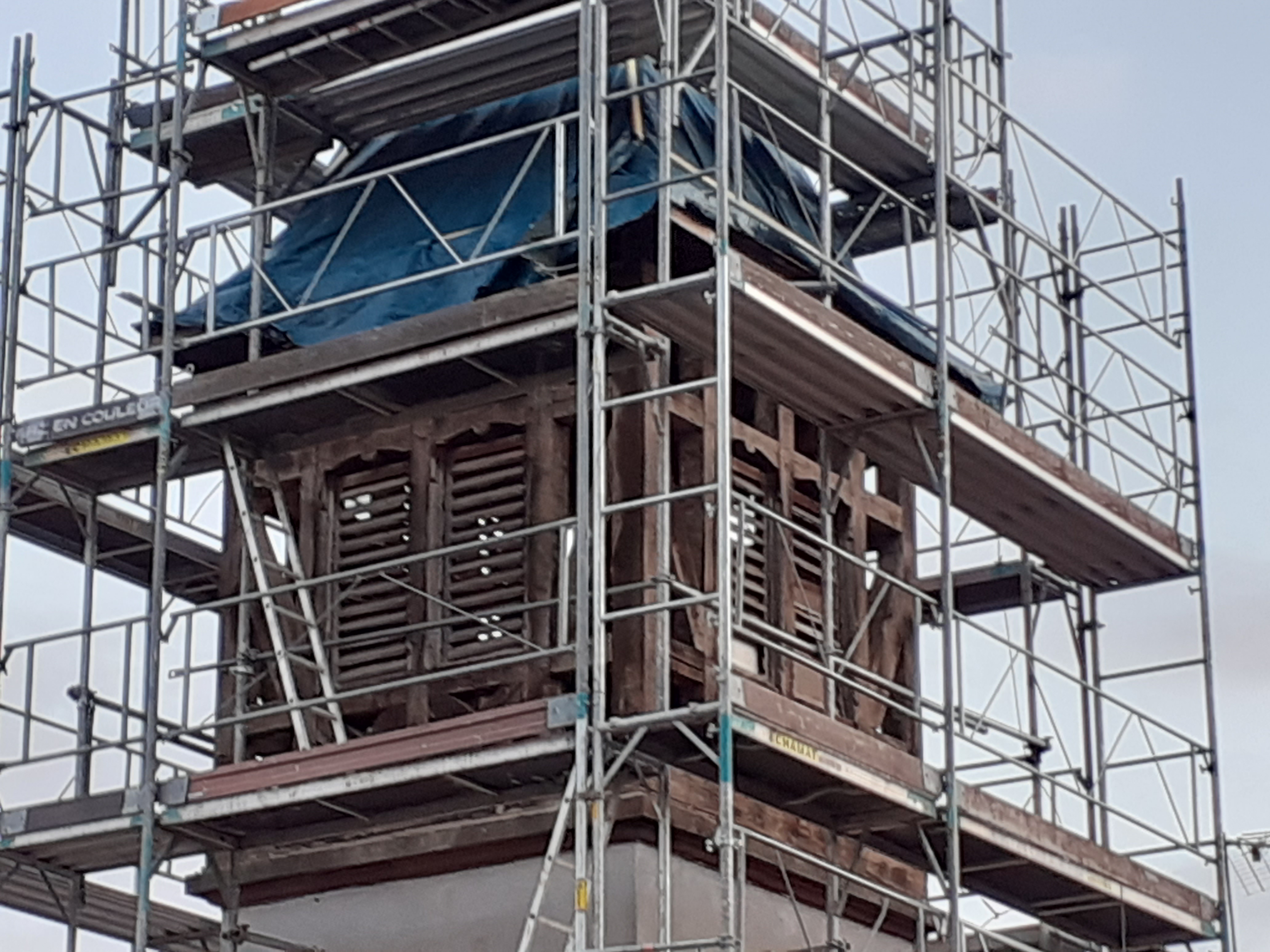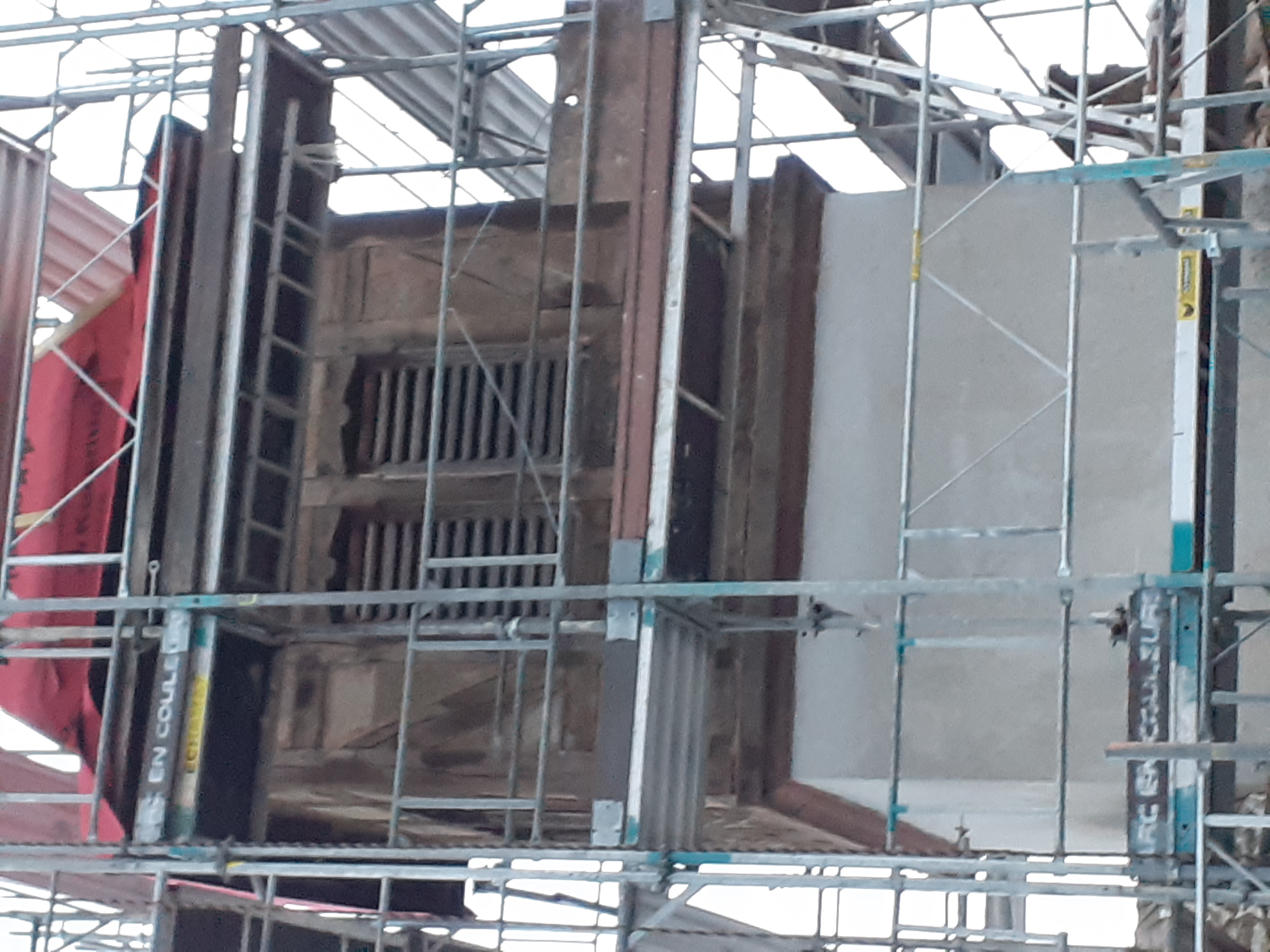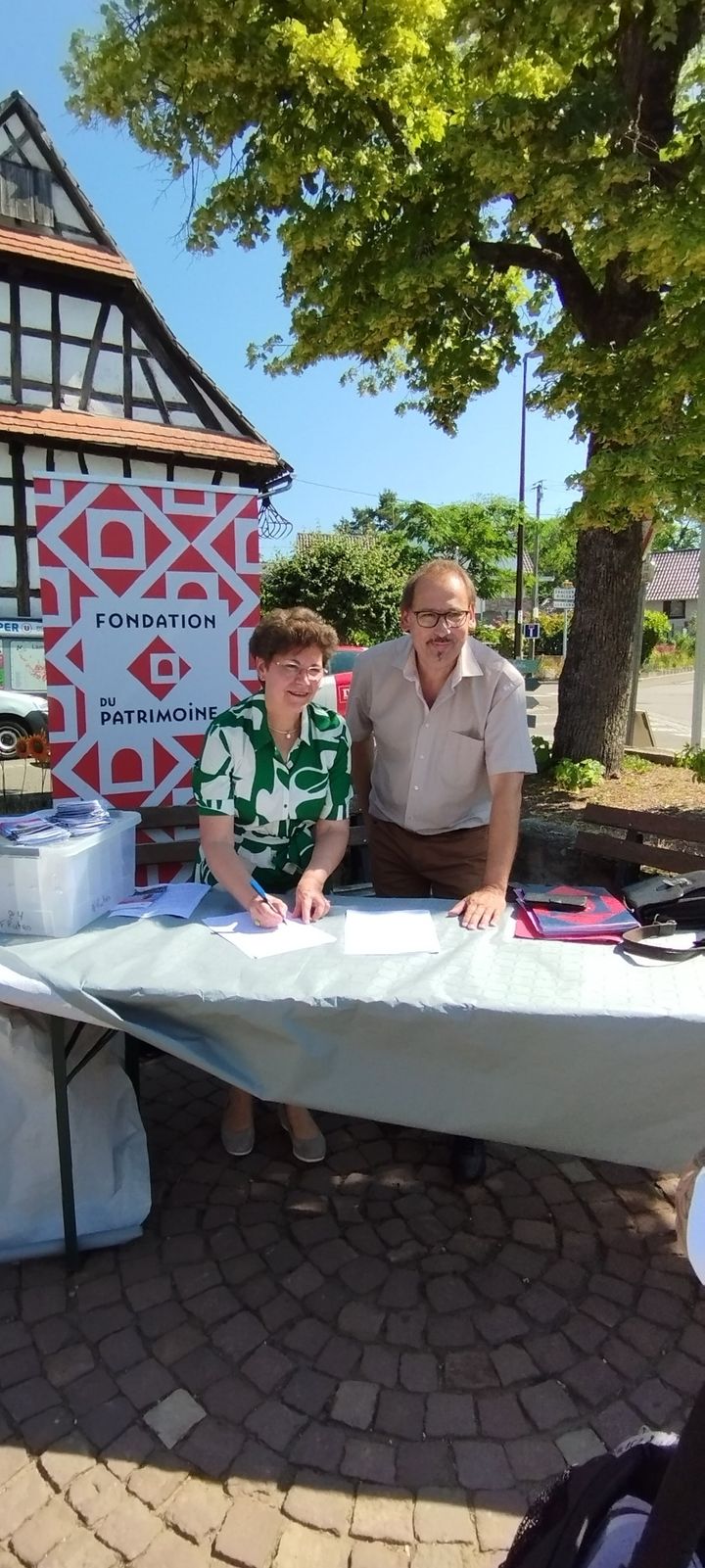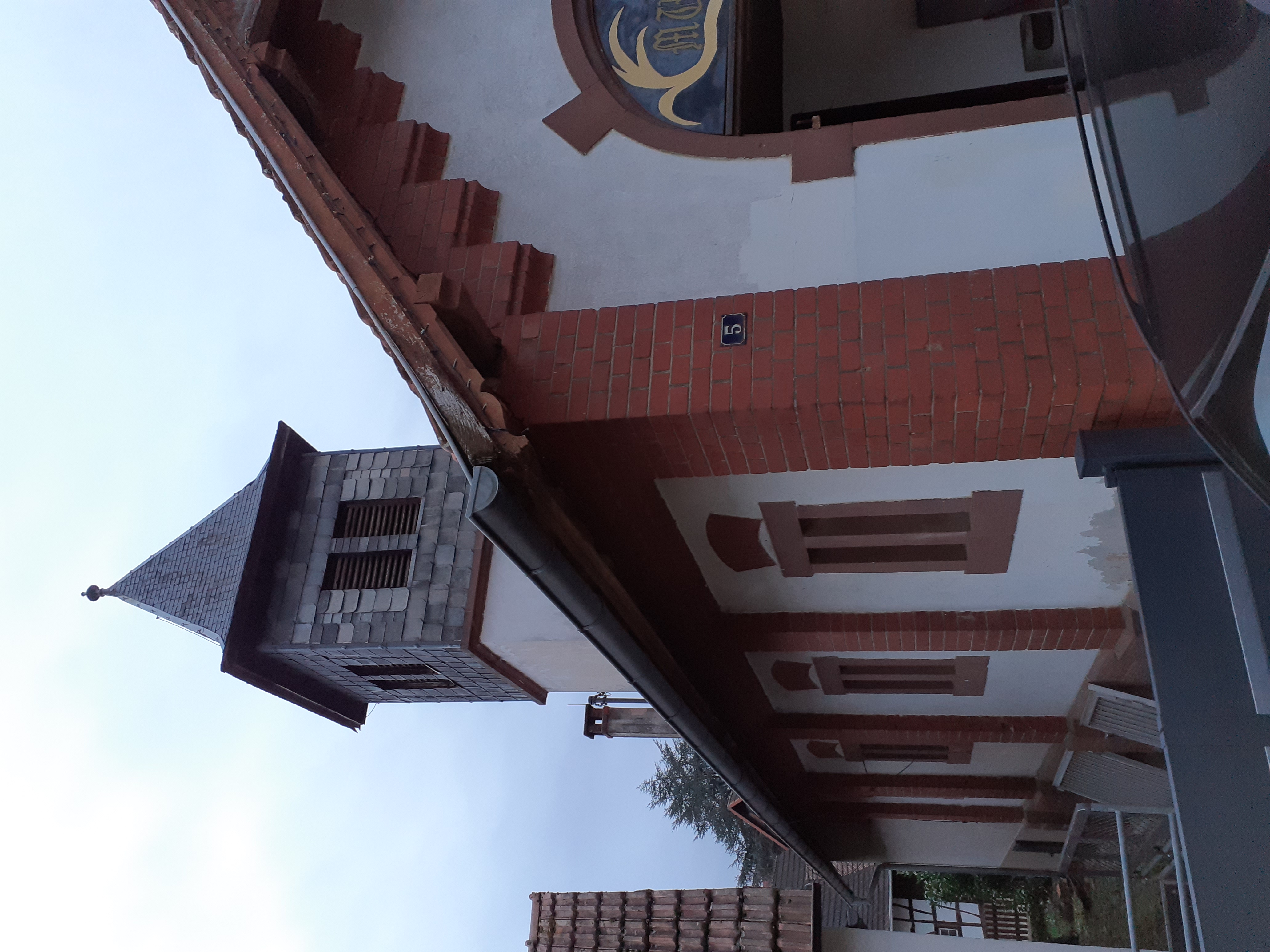Sprietzhiesel: Intergenerational Space
Sprietzhiesel: Revitalising Heritage for Community, Creativity, and Sustainability in Lampertsloch
Reviving a historic treasure in the heart of Lampertsloch, Sprietzhiesel is transforming into a vibrant, intergenerational hub for local communities. The space will offer a wide range of activities, from crochet workshop to family-friendly swap events, fostering connection, creativity, and shared memories, while promoting the circular economy. This project honors the region's rich cultural heritage and supports the future of inclusive, sustainable spaces for all.
France
Place du Tilleul, Lampertsloch
Prototype level
Yes
Yes
Yes
No
No
67257: Lampertsloch (FR)
The Spritzhiesel project aims to restore a historic building in Lampertsloch, Northern France, and transform it into a vibrant, intergenerational community space. Built in the late 19th century as a washhouse, the building reflects the architectural style of its era and preserves the village’s cultural heritage. The renovation will revitalize the space, becoming a meeting point for local residents, tourists, children, and seniors.
The project promotes inclusive participation by offering a venue where local associations can organize activities such as crochet, embroidery workshops, kids’ events, swap practices, and a café. By combining creative, educational, and social initiatives, the space will foster connections across generations and talents. Additionally, the project supports heritage conservation and boosts local tourism by linking the building to regional trekking paths.
Expected outcomes include enhanced community cohesion, sustainable social practices, and the preservation of cultural identity through a participatory approach. Aligned with New European Bauhaus principles, the project emphasizes sustainability, inclusivity, and beauty, creating a space that honors history while encouraging future-focused, collective engagement. This initiative showcases the transformative power of small-scale local actions and provides a model for rural and urban communities to replicate.
The project promotes inclusive participation by offering a venue where local associations can organize activities such as crochet, embroidery workshops, kids’ events, swap practices, and a café. By combining creative, educational, and social initiatives, the space will foster connections across generations and talents. Additionally, the project supports heritage conservation and boosts local tourism by linking the building to regional trekking paths.
Expected outcomes include enhanced community cohesion, sustainable social practices, and the preservation of cultural identity through a participatory approach. Aligned with New European Bauhaus principles, the project emphasizes sustainability, inclusivity, and beauty, creating a space that honors history while encouraging future-focused, collective engagement. This initiative showcases the transformative power of small-scale local actions and provides a model for rural and urban communities to replicate.
Gathering
Collaboration
Sustainability
Creativity
Sharing
The Spritzhiesel project champions sustainability by giving new life to a historic washhouse in Lampertsloch. Through its renovation, we preserve a cultural landmark while incorporating sustainable practices that align with the NEB principles of circularity and community cohesion.
1. Preservation and Resource Efficiency
The project breathes new life into the building, reusing existing materials. For example, the original slate roof tiles were recycled and hand-cut into heart-shaped souvenirs for local residents, offering both a keepsake and a way to reduce waste.
2. Circular Economy Practices
Spritzhiesel will foster a circular economy by serving as a hub for the exchange of items such as clothes, books, and toys. This initiative encourages recycling and reusing goods within the community, promoting sustainable consumption while strengthening social ties.
3. Social Sustainability
The space will host intergenerational activities, such as crochet workshops focused on t-shirt recycling, where participants transform old fabrics into yarn. This sustainable practice not only empowers residents to create and share goods but also reduces textile waste, minimizing reliance on mass production. By promoting the reuse of materials and sharing skills, the initiative contributes to sustainable social practices and enhances the circular economy within the community.
4. Local and Sustainable Tourism
Located at the start of four trekking paths, Spritzhiesel will support eco-friendly tourism, helping to sustain the local economy while respecting the region’s cultural heritage. This promotes environmentally-conscious travel and strengthens community ties.
5. Community Ownership and Long-term Impact
By involving local residents in the future management of Spritzhiesel, we ensure its long-term sustainability. This participatory model fosters a sense of ownership, guaranteeing that the space remains a vibrant part of the community for years to come.
1. Preservation and Resource Efficiency
The project breathes new life into the building, reusing existing materials. For example, the original slate roof tiles were recycled and hand-cut into heart-shaped souvenirs for local residents, offering both a keepsake and a way to reduce waste.
2. Circular Economy Practices
Spritzhiesel will foster a circular economy by serving as a hub for the exchange of items such as clothes, books, and toys. This initiative encourages recycling and reusing goods within the community, promoting sustainable consumption while strengthening social ties.
3. Social Sustainability
The space will host intergenerational activities, such as crochet workshops focused on t-shirt recycling, where participants transform old fabrics into yarn. This sustainable practice not only empowers residents to create and share goods but also reduces textile waste, minimizing reliance on mass production. By promoting the reuse of materials and sharing skills, the initiative contributes to sustainable social practices and enhances the circular economy within the community.
4. Local and Sustainable Tourism
Located at the start of four trekking paths, Spritzhiesel will support eco-friendly tourism, helping to sustain the local economy while respecting the region’s cultural heritage. This promotes environmentally-conscious travel and strengthens community ties.
5. Community Ownership and Long-term Impact
By involving local residents in the future management of Spritzhiesel, we ensure its long-term sustainability. This participatory model fosters a sense of ownership, guaranteeing that the space remains a vibrant part of the community for years to come.
The Sprietzhiesel project seeks to foster a welcoming environment that connects people to their cultural roots while offering a aesthetically pleasing and emotionally enriching space for the future.
1. Revitalizing Heritage through Design
The building’s renovation respects its historical architecture while integrating contemporary technologies, ensuring a harmonious balance between past and present. The warm, inviting design encourages visitors to appreciate the building’s cultural significance, making it an accessible space for community activities and creative expression.
2. Emotional and Inclusive Experience
Spritzhiesel’s design prioritizes accessible layouts and noble materials to create a sensory experience that evokes positive emotions. Thoughtful details, such as local craftsmanship and design elements, enhance the connection between visitors and the space, fostering an uplifting atmosphere for all ages.
3. Cultural and Artistic Engagement
The project supports local culture by hosting crochet, embroidery, and sewing with recycled materials. These initiatives celebrate traditional crafts while encouraging sustainability. Additionally, the space aims at welcoming local artists, with exhibitions, conferences, and cultural discussions, creating opportunities for artistic exchange and social cohesion.
4. Fostering Social Interaction and Beauty
Spritzhiesel’s design is centered on promoting social interaction and collective well-being. The café, workshops, and events will serve as gathering places for people to connect, exchange ideas, and engage in creative activities, contributing to a sense of beauty both in the environment and in the relationships it nurtures.
5. Exemplary in Aesthetic and Social Impact
By blending heritage, beauty, and functionality, Spritzhiesel serves as a model for how public spaces can enhance everyday life. It showcases how a community-driven approach to aesthetics and cultural life can foster long-term social benefits.
1. Revitalizing Heritage through Design
The building’s renovation respects its historical architecture while integrating contemporary technologies, ensuring a harmonious balance between past and present. The warm, inviting design encourages visitors to appreciate the building’s cultural significance, making it an accessible space for community activities and creative expression.
2. Emotional and Inclusive Experience
Spritzhiesel’s design prioritizes accessible layouts and noble materials to create a sensory experience that evokes positive emotions. Thoughtful details, such as local craftsmanship and design elements, enhance the connection between visitors and the space, fostering an uplifting atmosphere for all ages.
3. Cultural and Artistic Engagement
The project supports local culture by hosting crochet, embroidery, and sewing with recycled materials. These initiatives celebrate traditional crafts while encouraging sustainability. Additionally, the space aims at welcoming local artists, with exhibitions, conferences, and cultural discussions, creating opportunities for artistic exchange and social cohesion.
4. Fostering Social Interaction and Beauty
Spritzhiesel’s design is centered on promoting social interaction and collective well-being. The café, workshops, and events will serve as gathering places for people to connect, exchange ideas, and engage in creative activities, contributing to a sense of beauty both in the environment and in the relationships it nurtures.
5. Exemplary in Aesthetic and Social Impact
By blending heritage, beauty, and functionality, Spritzhiesel serves as a model for how public spaces can enhance everyday life. It showcases how a community-driven approach to aesthetics and cultural life can foster long-term social benefits.
The project fosters inclusion, participation, and collaboration, creating a space where all community members, regardless of age, background, or ability, can engage, contribute, and benefit. Prioritizing accessibility, affordability (eliminating financial barriers to participation), and participatory design, this initiative aims to be a model for inclusive community spaces.
1. Accessibility and Affordability
The renovation ensures the space is accessible to everyone, including those with limited mobility. The layout accommodates a range of needs, providing easy access for all.
2. Participatory Design and Community Ownership
Spritzhiesel’s development was a collaborative process, involving local residents and stakeholders in the design and planning stages. This participatory approach ensures the space reflects the community’s needs and desires. Local associations and residents are encouraged to lead activities, fostering ownership and responsibility.
3. Inclusive Programs and Activities
The project promotes social cohesion by offering intergenerational and cross-cultural activities, such as workshops, cultural discussions, and social gatherings. These initiatives encourage participation from all groups within the community, bridging generational gaps and fostering mutual learning.
4. Collaborative Community Hub
Spritzhiesel will bring together local artists, organizations, and residents to share knowledge and resources. Exhibitions, conferences, and cultural events will facilitate dialogue, creative partnerships, and strengthen social ties, empowering individuals to co-create a dynamic, inclusive environment.
5. Exemplary in Inclusive Practices
Spritzhiesel exemplifies how thoughtful design, affordable access, and active participation create a vibrant, welcoming space for all. Inclusive spaces not only enhance quality of life but also empower communities to drive their own development, leading to sustainable, collaborative societal models.
1. Accessibility and Affordability
The renovation ensures the space is accessible to everyone, including those with limited mobility. The layout accommodates a range of needs, providing easy access for all.
2. Participatory Design and Community Ownership
Spritzhiesel’s development was a collaborative process, involving local residents and stakeholders in the design and planning stages. This participatory approach ensures the space reflects the community’s needs and desires. Local associations and residents are encouraged to lead activities, fostering ownership and responsibility.
3. Inclusive Programs and Activities
The project promotes social cohesion by offering intergenerational and cross-cultural activities, such as workshops, cultural discussions, and social gatherings. These initiatives encourage participation from all groups within the community, bridging generational gaps and fostering mutual learning.
4. Collaborative Community Hub
Spritzhiesel will bring together local artists, organizations, and residents to share knowledge and resources. Exhibitions, conferences, and cultural events will facilitate dialogue, creative partnerships, and strengthen social ties, empowering individuals to co-create a dynamic, inclusive environment.
5. Exemplary in Inclusive Practices
Spritzhiesel exemplifies how thoughtful design, affordable access, and active participation create a vibrant, welcoming space for all. Inclusive spaces not only enhance quality of life but also empower communities to drive their own development, leading to sustainable, collaborative societal models.
The Spritzhiesel project is inherently participatory, with active involvement from local citizens and civil society throughout its development and operation. The community will play a central role in managing the space, with local associations rotating to ensure regular openings and offering a variety of activities. This collaborative approach allows citizens to directly shape the programming and ensure it reflects their interests and needs.
In addition to associations, private citizens will have the opportunity to propose activities, workshops, and events, fostering a culture of collective responsibility. This open structure ensures the space remains dynamic, inclusive, and responsive to the changing needs of the community. The local authority will provide guidance and support, but the initiative’s success depends on the active participation of residents.
This model of citizen involvement will strengthen social ties, empower individuals to take ownership of their local environment, and promote a sense of belonging. The diverse contributions from all members will ensure that the space remains vibrant, adaptable, and inclusive, contributing to long-term social cohesion and community resilience.
In addition to associations, private citizens will have the opportunity to propose activities, workshops, and events, fostering a culture of collective responsibility. This open structure ensures the space remains dynamic, inclusive, and responsive to the changing needs of the community. The local authority will provide guidance and support, but the initiative’s success depends on the active participation of residents.
This model of citizen involvement will strengthen social ties, empower individuals to take ownership of their local environment, and promote a sense of belonging. The diverse contributions from all members will ensure that the space remains vibrant, adaptable, and inclusive, contributing to long-term social cohesion and community resilience.
The design and implementation of the Spritzhiesel project has involved a diverse range of stakeholders at the local, national, and European levels, ensuring its relevance and sustainability.
At the local level, the project has been led by community members, with local associations, residents, and the municipal authorities actively shaping the space’s design and programming. Local enterprises based in Lampertsloch have carried out the renovation works, strengthening the village’s economy and ensuring that the project is deeply connected to the community.
At the national level, the Fondation du Patrimoine has played a crucial role in collecting donations and securing financial support for the building’s restoration. Their involvement has helped to amplify the project's impact, securing necessary funding while preserving the cultural heritage of the site.
On a European scale, the project holds great potential for resonance due to its scalability. The model of restoring small historical buildings to serve as community hubs is easily replicable in other rural or urban settings across Europe. By promoting social cohesion, cultural preservation, and sustainable design, the project aligns with broader European objectives, making it a promising example of how local initiatives can drive broader change.
By engaging these stakeholders, the project has created a strong, collaborative foundation that ensures long-term impact and community-driven development.
At the local level, the project has been led by community members, with local associations, residents, and the municipal authorities actively shaping the space’s design and programming. Local enterprises based in Lampertsloch have carried out the renovation works, strengthening the village’s economy and ensuring that the project is deeply connected to the community.
At the national level, the Fondation du Patrimoine has played a crucial role in collecting donations and securing financial support for the building’s restoration. Their involvement has helped to amplify the project's impact, securing necessary funding while preserving the cultural heritage of the site.
On a European scale, the project holds great potential for resonance due to its scalability. The model of restoring small historical buildings to serve as community hubs is easily replicable in other rural or urban settings across Europe. By promoting social cohesion, cultural preservation, and sustainable design, the project aligns with broader European objectives, making it a promising example of how local initiatives can drive broader change.
By engaging these stakeholders, the project has created a strong, collaborative foundation that ensures long-term impact and community-driven development.
The design and implementation of the Spritzhiesel project have brought together multiple disciplines, ensuring a holistic approach to creating a sustainable, inclusive, and culturally rich space.
Architecture and Heritage Preservation played a central role, with professionals working on restoring the historic building while preserving its cultural significance. Experts in construction and engineering ensured the building met modern safety and accessibility standards, including the integration of sustainable materials and energy-efficient systems.
Urban Planning and Community Development were key in shaping the project’s design to ensure it would serve the needs of diverse groups. Local authorities and residents participated in consultations, offering valuable input on the space’s function and accessibility. This participatory design approach ensured that the space would foster social cohesion and inclusivity.
Cultural and Artistic expertise has also been integral, as the project seeks to offer a vibrant cultural hub. Local artists and cultural organizations are involved in providing workshops, exhibitions, and community events. Their contributions create an atmosphere of creativity and cultural exchange, enriching the space for all visitors.
The interaction between these fields—heritage, construction, community planning, and culture—has been invaluable. The collaboration has ensured the project respects historical heritage while meeting the modern needs of the community. The integration of various perspectives has resulted in a well-rounded, functional, and inspiring space that serves as a model for community-driven regeneration.
Architecture and Heritage Preservation played a central role, with professionals working on restoring the historic building while preserving its cultural significance. Experts in construction and engineering ensured the building met modern safety and accessibility standards, including the integration of sustainable materials and energy-efficient systems.
Urban Planning and Community Development were key in shaping the project’s design to ensure it would serve the needs of diverse groups. Local authorities and residents participated in consultations, offering valuable input on the space’s function and accessibility. This participatory design approach ensured that the space would foster social cohesion and inclusivity.
Cultural and Artistic expertise has also been integral, as the project seeks to offer a vibrant cultural hub. Local artists and cultural organizations are involved in providing workshops, exhibitions, and community events. Their contributions create an atmosphere of creativity and cultural exchange, enriching the space for all visitors.
The interaction between these fields—heritage, construction, community planning, and culture—has been invaluable. The collaboration has ensured the project respects historical heritage while meeting the modern needs of the community. The integration of various perspectives has resulted in a well-rounded, functional, and inspiring space that serves as a model for community-driven regeneration.
Unlike conventional projects that focus solely on restoration or tourism, this initiative combines heritage conservation with dynamic community engagement, creating a multifunctional space that fosters local involvement and social cohesion.
One of the key innovations lies in its participatory design model. Rather than being top-down, the project is driven by the active participation of local residents, associations, and artists, ensuring that the space reflects the community’s needs and aspirations. This approach contrasts with more traditional models where design decisions are typically made by a limited group of professionals.
Additionally, the project emphasizes sustainability and circular economy principles in its design and activities. For example, community-driven workshops—such as crochet using recycled fabric—promote local craftsmanship and sustainable consumption. This focus on reusing materials and fostering collaborative creation goes beyond mere conservation, integrating social and environmental goals.
Finally, the initiative’s scalability is a unique feature. By offering a replicable model of restoring and adapting historic spaces for community use, the project provides a framework that can be applied to similar small towns across Europe, making it an innovative solution for broader urban and rural regeneration efforts.
One of the key innovations lies in its participatory design model. Rather than being top-down, the project is driven by the active participation of local residents, associations, and artists, ensuring that the space reflects the community’s needs and aspirations. This approach contrasts with more traditional models where design decisions are typically made by a limited group of professionals.
Additionally, the project emphasizes sustainability and circular economy principles in its design and activities. For example, community-driven workshops—such as crochet using recycled fabric—promote local craftsmanship and sustainable consumption. This focus on reusing materials and fostering collaborative creation goes beyond mere conservation, integrating social and environmental goals.
Finally, the initiative’s scalability is a unique feature. By offering a replicable model of restoring and adapting historic spaces for community use, the project provides a framework that can be applied to similar small towns across Europe, making it an innovative solution for broader urban and rural regeneration efforts.
The methodology behind the Spritzhiesel project is centered on participatory design, sustainability, and community-driven development. The initiative takes a holistic, inclusive approach to ensure it meets the needs of diverse groups while preserving cultural heritage.
1. Participatory Design: The project actively involves local residents, associations, and other community stakeholders in every phase. From the initial planning and design stages to the implementation and ongoing programming, community input shapes the decision-making process. This ensures the space reflects the local culture and needs, empowering citizens to take ownership and responsibility for the space’s long-term success.
2. Sustainable Practices: The renovation integrates sustainable building practices, focusing on energy-efficient solutions, the use of eco-friendly materials, and the restoration of the existing structure. The project also encourages sustainable behaviors through its programming, such as promoting the circular economy by recycling materials in workshops and facilitating the exchange of goods among community members.
3. Interdisciplinary Collaboration: The project brings together experts from various fields, including heritage preservation, architecture, urban planning, and community development. This collaborative approach ensures that all aspects—cultural, social, environmental, and economic—are addressed, creating a balanced and well-rounded initiative.
4. Scalability: The design and methodology are structured in a way that allows the project to be easily replicated in other small towns across Europe, making it a scalable model for inclusive, sustainable community regeneration.
1. Participatory Design: The project actively involves local residents, associations, and other community stakeholders in every phase. From the initial planning and design stages to the implementation and ongoing programming, community input shapes the decision-making process. This ensures the space reflects the local culture and needs, empowering citizens to take ownership and responsibility for the space’s long-term success.
2. Sustainable Practices: The renovation integrates sustainable building practices, focusing on energy-efficient solutions, the use of eco-friendly materials, and the restoration of the existing structure. The project also encourages sustainable behaviors through its programming, such as promoting the circular economy by recycling materials in workshops and facilitating the exchange of goods among community members.
3. Interdisciplinary Collaboration: The project brings together experts from various fields, including heritage preservation, architecture, urban planning, and community development. This collaborative approach ensures that all aspects—cultural, social, environmental, and economic—are addressed, creating a balanced and well-rounded initiative.
4. Scalability: The design and methodology are structured in a way that allows the project to be easily replicated in other small towns across Europe, making it a scalable model for inclusive, sustainable community regeneration.
Several elements of the Spritzhiesel project can be replicated or transferred to other locations, groups of beneficiaries, and contexts, offering a scalable model for community-driven regeneration and sustainable development.
Participatory Design Model: The process of involving local residents, associations, and stakeholders in decision-making and design can be adapted to other communities. This inclusive approach ensures that the spaces meet the needs of those who will use them, creating a sense of ownership and responsibility.
Sustainability and Circular Economy Practices: The emphasis on sustainability, including energy-efficient renovation and the reuse of materials, can be easily adopted in similar heritage conservation projects. The workshops focused on recycling, such as crochet using upcycled fabrics, as well as the swap and play events promote local craftsmanship while encouraging sustainable consumption—practices that can be applied to other towns and villages.
Cultural and Social Programming: The model of using restored historical buildings as cultural hubs for intergenerational, cross-cultural, and educational activities can be replicated. Offering a range of low-cost or free activities that promote social cohesion and cultural exchange can be applied to diverse settings, from rural villages to urban neighborhoods.
Scalable Structure: The project’s approach is adaptable, particularly the concept of transforming underutilized heritage spaces into community-centered hubs. This can be transferred to other small towns or cities, preserving local heritage while creating dynamic, inclusive spaces.
By incorporating these elements, the Spritzhiesel project can inspire similar initiatives in different locations, fostering broader social and cultural regeneration.
Participatory Design Model: The process of involving local residents, associations, and stakeholders in decision-making and design can be adapted to other communities. This inclusive approach ensures that the spaces meet the needs of those who will use them, creating a sense of ownership and responsibility.
Sustainability and Circular Economy Practices: The emphasis on sustainability, including energy-efficient renovation and the reuse of materials, can be easily adopted in similar heritage conservation projects. The workshops focused on recycling, such as crochet using upcycled fabrics, as well as the swap and play events promote local craftsmanship while encouraging sustainable consumption—practices that can be applied to other towns and villages.
Cultural and Social Programming: The model of using restored historical buildings as cultural hubs for intergenerational, cross-cultural, and educational activities can be replicated. Offering a range of low-cost or free activities that promote social cohesion and cultural exchange can be applied to diverse settings, from rural villages to urban neighborhoods.
Scalable Structure: The project’s approach is adaptable, particularly the concept of transforming underutilized heritage spaces into community-centered hubs. This can be transferred to other small towns or cities, preserving local heritage while creating dynamic, inclusive spaces.
By incorporating these elements, the Spritzhiesel project can inspire similar initiatives in different locations, fostering broader social and cultural regeneration.
The Spritzhiesel project offers local solutions to several pressing global challenges, focusing on sustainability, social inclusion, and heritage preservation.
Sustainability and Circular Economy: One of the most significant global challenges today is the need for sustainable development and reducing environmental impact. By using energy-efficient restoration practices, incorporating eco-friendly materials, and promoting recycling and reusing of goods (such as creating crochet from upcycled fabric or organising swap and play events), the initiative directly contributes to the circular economy. It encourages sustainable consumption and waste reduction at the local level, which, when scaled, can have a broader environmental impact.
Social Cohesion and Inclusion: The world faces rising inequalities and social fragmentation. The Spritzhiesel project directly addresses this by creating an inclusive space where people of all ages, backgrounds, and abilities can come together. Offering affordable and free activities fosters community engagement and intergenerational dialogue, helping bridge societal divides. The project’s participatory approach ensures that everyone has a voice in shaping the space, promoting equity and social justice.
Cultural Heritage Preservation: Many communities worldwide are at risk of losing their cultural heritage due to rapid urbanization and neglect. Spritzhiesel provides a model for preserving historical buildings while repurposing them for modern use. By restoring a 19th-century washhouse and integrating it into the daily life of the village, the project highlights how cultural preservation can coexist with contemporary needs, offering a model for other regions facing similar challenges.
Through these solutions, the Spritzhiesel project contributes to global goals while fostering local resilience and empowerment.
Sustainability and Circular Economy: One of the most significant global challenges today is the need for sustainable development and reducing environmental impact. By using energy-efficient restoration practices, incorporating eco-friendly materials, and promoting recycling and reusing of goods (such as creating crochet from upcycled fabric or organising swap and play events), the initiative directly contributes to the circular economy. It encourages sustainable consumption and waste reduction at the local level, which, when scaled, can have a broader environmental impact.
Social Cohesion and Inclusion: The world faces rising inequalities and social fragmentation. The Spritzhiesel project directly addresses this by creating an inclusive space where people of all ages, backgrounds, and abilities can come together. Offering affordable and free activities fosters community engagement and intergenerational dialogue, helping bridge societal divides. The project’s participatory approach ensures that everyone has a voice in shaping the space, promoting equity and social justice.
Cultural Heritage Preservation: Many communities worldwide are at risk of losing their cultural heritage due to rapid urbanization and neglect. Spritzhiesel provides a model for preserving historical buildings while repurposing them for modern use. By restoring a 19th-century washhouse and integrating it into the daily life of the village, the project highlights how cultural preservation can coexist with contemporary needs, offering a model for other regions facing similar challenges.
Through these solutions, the Spritzhiesel project contributes to global goals while fostering local resilience and empowerment.
The Spritzhiesel project is evolving through a series of planned activities designed to create an inclusive, sustainable, and beautiful community space that embodies the principles of the New European Bauhaus (NEB).
Planned Activities:
1. Renovation Completion: The restoration of the building is nearly complete, with final works focused on the inside of the building. The project will incorporate eco-friendly materials and sustainable building practices, ensuring minimal environmental impact.
2. Community Workshops and Gatherings: A range of intergenerational activities, such as crochet workshops (focused on recycling fabric), local art exhibitions, swap and play events, board games times, tea and coffee, reading circles, chess, qi-gong practices, drawing workshops will be hosted to foster social inclusion and creativity. These programs will provide opportunities for local residents to engage in creative collaboration.
3; Collaborations with Local Artists: The space will regularly host local artists and cultural practitioners for exhibitions, conferences, and collaborative projects, enriching the community with diverse artistic expressions.
Incorporating NEB Values and Principles:
1. Sustainability: The project integrates energy-efficient solutions, circular economy principles, and environmentally conscious building practices.
2. Inclusion: The space is designed to be accessible to all, ensuring affordability for every community member. Local residents actively participate in the design and management of the space, promoting a sense of ownership.
3. Beauty: The renovation preserves the historical charm of the building, creating a beautiful environment where people can connect and create.
Next Steps:
Expand community-led activities.
Engage local associations to ensure long-term sustainability.
Continue to create a model for other small towns across Europe, amplifying the impact of local solutions.
Planned Activities:
1. Renovation Completion: The restoration of the building is nearly complete, with final works focused on the inside of the building. The project will incorporate eco-friendly materials and sustainable building practices, ensuring minimal environmental impact.
2. Community Workshops and Gatherings: A range of intergenerational activities, such as crochet workshops (focused on recycling fabric), local art exhibitions, swap and play events, board games times, tea and coffee, reading circles, chess, qi-gong practices, drawing workshops will be hosted to foster social inclusion and creativity. These programs will provide opportunities for local residents to engage in creative collaboration.
3; Collaborations with Local Artists: The space will regularly host local artists and cultural practitioners for exhibitions, conferences, and collaborative projects, enriching the community with diverse artistic expressions.
Incorporating NEB Values and Principles:
1. Sustainability: The project integrates energy-efficient solutions, circular economy principles, and environmentally conscious building practices.
2. Inclusion: The space is designed to be accessible to all, ensuring affordability for every community member. Local residents actively participate in the design and management of the space, promoting a sense of ownership.
3. Beauty: The renovation preserves the historical charm of the building, creating a beautiful environment where people can connect and create.
Next Steps:
Expand community-led activities.
Engage local associations to ensure long-term sustainability.
Continue to create a model for other small towns across Europe, amplifying the impact of local solutions.

